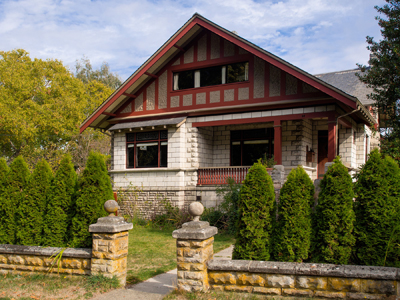Heritage Register
Fairfield
97 Cook Street
Built
1911
Heritage-Designated 2014
For: John Avery
Designer/Builder: John Avery

ARCHITECTURE:
This house is a fitting mate to its more elaborate neighbour, 139 Cook St. As Craftsman Bungalows are usually of wood construction, and any artificial stone or concrete block house is rare in Victoria, it is doubly uncommon to find an artificial stone Craftsman Bungalow such as this one. Concrete block was an innovative building material in 1911. This 1½-storey, front-gabled house has shallow cross-gabled bays on either side. A stone staircase leads up to an inset entry porch on the right corner with two chamfered square columns on artificial stone piers and a wooden balustrade. A shallow 1-storey rectangular bay with a shed roof on the left balances the entry porch. (There is an inset left corner rear entry porch.) The front gable window has been replaced with a wider modern sash. The second storey is clad in roughcast and half-timbering. The remainder of the building is artificial stone of several textures: the basement level is laid in irregular courses, while the first floor is composed of regular-coursed smooth masonry resembling limestone with rough corner quoins simulating granite. The roof has the characteristic Craftsman exposed raftertails under the eaves and projecting beam-ends in the gables, and is covered with slate. A boundary wall at the front of the property is also of artificial stone.
ORIGINAL OCCUPANTS:
John Avery paid the assessments on this property from 1910-12, then sold to Capt William Henry (1861-1927) and Elizabeth Martha (Bury, 1864-1945) Logan. Capt Logan was born to Scottish parents in Liverpool, England. He began his career on sailing ships, then served in the British Navy. The Logans immigrated to BC c.1908. From then until his death, Logan, as agent for the London Salvage Association, superintended the salvaging of shipwrecks (if the vessel was underwritten by LSA) on the Pacific Coast from Panama to Alaska. One of the outstanding points of his career was the refloating of the steamer Sesostris, which had been stranded on the shore of Guatemala, “lifted high and dry by tidal convulsion.”
Logan designed the Pacific Salvage steamer Salvage King, and it was this vessel that conveyed his remains home to Victoria after his death in Vancouver in 1927. According to the Victoria Daily Times of March 7, “The casket, which was carried on the deck, was covered with wreaths and floral offerings from shipping firms and friends in Vancouver, and was carried down the gangplank by eight members of the crew to the waiting hearse, while the silent watchers stood bareheaded.” One who accompanied the body to Victoria and served as a pallbearer was Andrew Wallace, head of Burrard Drydock Co. Others were shipping men from Seattle, Portland, and BC.
OTHER OCCUPANTS:
Elizabeth Logan lived in this house until her death.
Widow Florence E. McIlroy lived here in 1946. Hugh Baldwin (1890-1970) and Mona Patricia (Weston, 1920-1979) Pratt bought this house in the late 1940s and lived here until 1951. Hugh was a Canadian Government accountant and Mona, an aide at St. Joseph’s Hospital.

